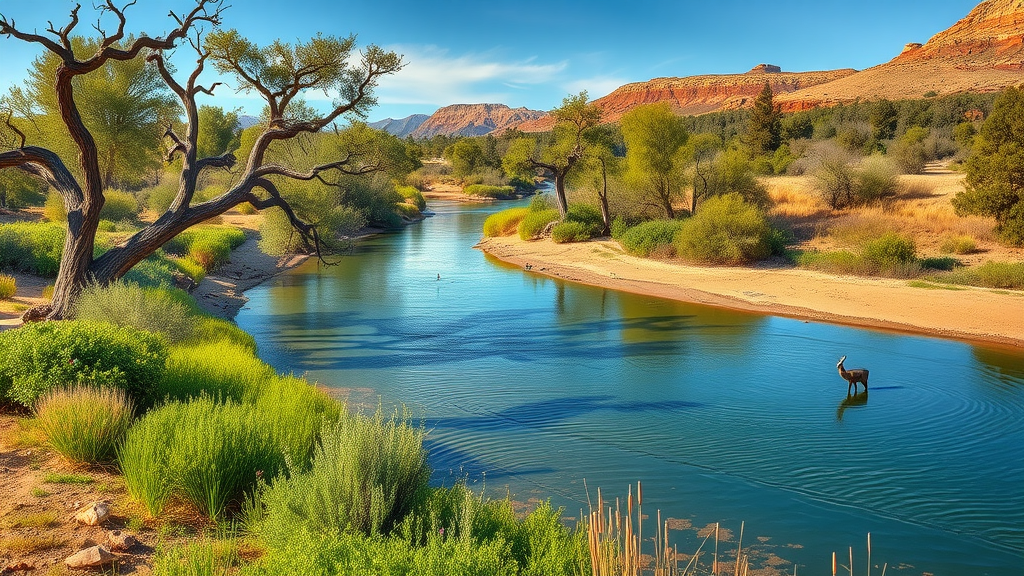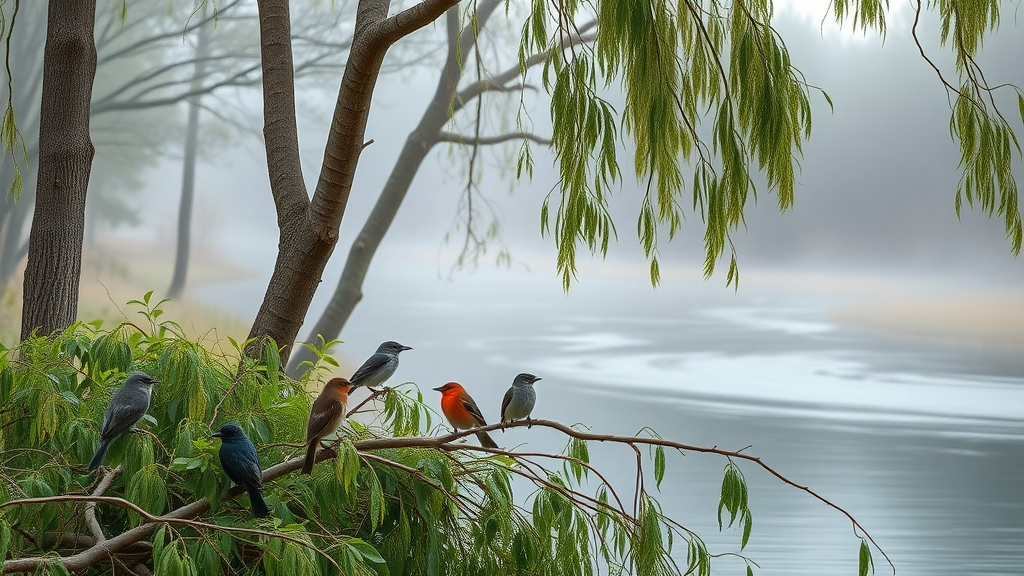Unveiling One of Arizona’s Last Wild River Habitats: Why Bill Williams River National Wildlife Refuge Matters
Picture a place where ancient forests still thrive, where the desert meets flowing water, and where rare birds find sanctuary. The Bill Williams River National Wildlife Refuge is more than just a scenic stop along Arizona’s Lower Colorado River; it’s a living, breathing fragment of an ecosystem that has all but vanished in the American Southwest. For those seeking a true window into the natural past—and a critical lesson about the future—this refuge offers an unparalleled opportunity. With dramatically contrasting landscapes spanning riverine forests and cattail marshes, few places in the region provide such solitude, biodiversity, and inspiration in one spot.
Yet, while stunning views and wildlife encounters greet the casual visitor, the real story unfolds beneath the surface. At stake is one of the last stands of naturally regenerated cottonwood-willow forest—an irreplaceable ecosystem teeming with rare and endangered species. It’s a living classroom for understanding how vital river habitats are, not only to the creatures of the desert but also to the legacy of conservation in America. As you read on, you’ll discover why the Bill Williams River National Wildlife Refuge is both a hidden treasure and an urgent reminder of what’s at risk if these landscapes fade.

Biodiversity and Balance: What Makes the Bill Williams River National Wildlife Refuge a Southwest Sanctuary?
What defines a vibrant ecosystem in the desert southwest? At the Bill Williams River National Wildlife Refuge, the answer lies in the rare convergence of riparian forest, marshland, and desert terrain. Spanning more than 6,100 acres, the refuge preserves a critical corridor of life for plants and animals accustomed to the harsh realities of the region. Instead of arid monotony, visitors experience a tapestry of life—twisting cottonwoods, dense willows, bustling songbirds, and secretive marsh dwellers. This structure forms a unique desert oasis unlike most you’ll find along the Lower Colorado River.
Not understanding the importance of these habitats can have lasting consequences—especially when you consider that the refuge protects the last ecologically functioning river systems of the southwest. Cottonwood-willow forests, once common along the river, are now threatened remnants. These woodlands, along with cattail marshes, provide essential breeding grounds for species such as the endangered southwestern willow flycatcher and the threatened yellow-billed cuckoo. Without places like the Bill Williams River National Wildlife Refuge, these species—and the intricate natural relationships they represent—edge perilously closer to extinction. Knowing their stories compels action, fosters appreciation, and fosters support for continued conservation.

Why Bill Williams River National Wildlife Refuge is Crucial for Wildlife, Conservation, and Future Generations
The Bill Williams River National Wildlife Refuge serves as more than a picturesque landscape; it’s a vital haven where wildlife conservation comes alive. Guided by the mission of the National Wildlife Refuge System and the oversight of the U.S. Fish and Wildlife Service, this refuge ensures that wildlife remains at the heart of everything it does. These principles drive the establishment, recreational accessibility, and the complex management strategies designed to protect this rare habitat. For visitors, it means the rare chance to witness ecological processes and see native wildlife in its natural context—an invaluable experience for families, students, and anyone curious about the natural world.
The value of this refuge is evident in every aspect—from its tranquil walking trails abutting the river, to interpretive signs that offer insight into the complexity of desert life. Whether you’re spotting an Abert’s towhee among the cottonwoods or listening for the call of the yellow-billed cuckoo, the refuge is a living testament to successful, ongoing environmental stewardship. Spending time here not only connects visitors with Arizona’s ancient landscapes, but also underscores the critical role each person plays in safeguarding these ecosystems for generations to come.

Preserving Arizona’s Natural Legacy: The Historical Roots and Evolution of the Refuge
To truly appreciate the significance of the Bill Williams River National Wildlife Refuge, understanding its history is essential. In 1993, a vision to protect Arizona’s remaining wild river habitats led to the designation of 6,100 acres from the Havasu Lake National Wildlife Refuge. This decision was grounded in the landscape’s remarkable biodiversity and ecological uniqueness. Over the decades, the refuge has become an enduring symbol of conservation, displaying the landscape as it looked centuries ago—before widespread development and water diversion altered the Lower Colorado’s course.
By maintaining one of the last stands of naturally regenerated cottonwood-willow forest, the refuge not only provides critical habitat but also keeps historical ecosystems alive for study and appreciation. Such preservation is rare, particularly in arid regions where water and habitat fragmentation threaten so many species. For researchers, outdoor lovers, and local communities, the refuge is both an ecological anchor and a living memorial to Arizona’s wild past.
Experiencing the Refuge: Tips for Visitors and Opportunities for Connection
A visit to the Bill Williams River National Wildlife Refuge offers multiple ways to connect with nature—by foot, by boat, or simply by pausing to observe. Well-maintained headquarters trails give families and wildlife enthusiasts the chance to explore riparian forests and riverbanks, while interpretive signs provide engaging, educational stops along the way. For photographers, the dramatic landscape, abundant birdlife, and ever-changing light create perfect conditions to capture the American Southwest’s beauty.

Planning a trip means choosing your own adventure—wandering a paved path along the water, seeking songbirds in the cottonwoods, or quietly watching marsh habitats for secretive birds. With something for every age and interest, the refuge promises an experience that’s immersive, memorable, and meaningful. Visitors are encouraged to check current trail conditions and seasonal highlights to make the most of every outing.
Every Bird Counts: The Refuge as a Sanctuary for Endangered and Threatened Species
The Bill Williams River National Wildlife Refuge plays a critical role in conserving bird populations that are at risk across the American Southwest. The riparian and marsh habitats it protects are essential for avian species, especially those dependent on rare desert waterways for survival. Among them are the endangered southwestern willow flycatcher and the threatened yellow-billed cuckoo, species whose futures depend on the refuge’s careful stewardship. In the marshes, birds like the endangered Yuma Ridgway’s rail find shelter and resources, attesting to the refuge’s ability to meet the specialized needs of diverse wildlife.
By supporting such intricate ecological webs, the refuge conveys the broader value of biodiversity and interdependence that all life relies on. These efforts highlight why carefully managed habitats are not only fascinating to explore but crucial to the region’s long-term ecological balance.
Guided by Nature: The Refuge’s Conservation Philosophy and Lasting Impact
At its core, the Bill Williams River National Wildlife Refuge is committed to conservation as an ongoing, dynamic process. The refuge is part of the National Wildlife Refuge System and guided by the U.S. Fish and Wildlife Service, meaning every decision is rooted in a philosophy that puts wildlife and habitat preservation first. This commitment is evident in habitats maintained, species protected, and the variety of recreational activities offered—all balanced to ensure that local plants and animals have a future here.
Understanding the delicate interplay of rivers, forest, marsh, and desert informs every action. Using resource management tools tailored to the needs of rare and threatened species, the refuge strives to keep natural systems not just intact, but thriving. The philosophy centers on long-term stewardship, recognizing that these wild places offer benefit far beyond today’s visitors—they provide a blueprint for future generations and a sanctuary for all wildlife. As a genuine living classroom, the refuge embodies the idea that careful, thoughtful management can result in truly irreplaceable natural spaces.
Real Encounters in the Wild: A Visitor’s Reflection on the Bill Williams River National Wildlife Refuge
For many, the true value of a wildlife refuge isn’t captured in facts or figures, but in moments of quiet discovery and personal connection. A single visitor’s experience can highlight what makes the Bill Williams River National Wildlife Refuge so memorable and important. One recent guest described their encounter this way:
A great stop to walk a paved path along the water. Path continues to gravel to reach the end of the peninsula. Good for kids with lots of info along the walkway. Nice opportunities to sit and contemplate and snap photos of the landscape.
This reflection mirrors the experience countless others have found here—a blend of accessibility, engagement, and the deep peace that only true natural places can provide. From educational details to places simply meant for contemplation, the refuge meets visitors where they are and offers something enduring to all. Embracing the journey is to step into an ecosystem both timeless and urgently relevant, ensuring future explorers enjoy the same wonders that grace the Lower Colorado today.
Defending a Wild Legacy: How the Bill Williams River National Wildlife Refuge Shapes Southwest Conservation
The Bill Williams River National Wildlife Refuge is more than a destination—it’s a testament to what’s possible when preservation is prioritized in the face of ecological change. Its rare habitats offer a model for sustaining desert biodiversity through science-driven management and a commitment to public education. By serving as both sanctuary and classroom, the refuge extends its influence far beyond its borders, inspiring anyone who visits or learns about it to protect wild places wherever they live. The legacy of the Bill Williams River National Wildlife Refuge is one of hope—protecting the past and shaping the conservation of tomorrow, one habitat at a time.
As a recognized leader in river habitat conservation, the Bill Williams River National Wildlife Refuge continues to set the standard for what thoughtful stewardship can achieve, ensuring the Lower Colorado remains a lifeline for both wildlife and people for generations to come.
Contact the Experts at Bill Williams River National Wildlife Refuge
If you’d like to learn more about how the Bill Williams River National Wildlife Refuge could connect you to Arizona’s unique river habitats and wildlife, contact the team at Bill Williams River National Wildlife Refuge.
📍 Address: Lake Havasu City, AZ 86406, USA
📞 Phone: +1 928-667-4144
🌐 Website: https://www.fws.gov/refuge/bill-williams-river
Bill Williams River National Wildlife Refuge Location and Availability
🕒 Hours of Operation:
📅 Monday: Open 24 hours
📅 Tuesday: Open 24 hours
📅 Wednesday: Open 24 hours
📅 Thursday: Open 24 hours
📅 Friday: Open 24 hours
📅 Saturday: Open 24 hours
📅 Sunday: Open 24 hours

 Add Row
Add Row  Add
Add 





Write A Comment